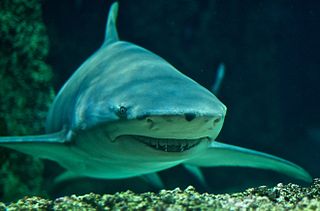
The snailfishes or sea snails, are a family of marine ray-finned fishes. These fishes make up the Liparidae, a family classified within the order Scorpaeniformes.

The sicklefin lemon shark or sharptooth lemon shark is a species of requiem shark belonging to the family Carcharhinidae, widely distributed in the tropical waters of the Indo-Pacific. It is closely related to the better-known lemon shark (N. brevirostris) of the Americas; the two species are almost identical in appearance, both being stout-bodied sharks with broad heads, two dorsal fins of nearly equal size, and a plain yellow-tinged coloration. As its common name suggests, the sicklefin lemon shark differs from its American counterpart in having more falcate (sickle-shaped) fins. This large species grows up to 3.8 m (12 ft) long. It generally inhabits water less than 92 m (302 ft) deep in a variety of habitats, from mangrove estuaries to coral reefs.

Negaprion is a genus of requiem sharks in the family Carcharhinidae. It contains the two extant species of lemon sharks: the lemon shark of the Americas, and the sicklefin lemon shark of the Indo-Pacific. Both species are large, slow-moving, bulky sharks inhabiting shallow coastal waters, and can be identified by their short, blunt snouts, two dorsal fins of nearly equal size, and uniform yellowish brown or gray coloration.

Carcharias is a genus of mackerel sharks belonging to the family Odontaspididae. Once bearing many prehistoric species, all have gone extinct with the exception of the critically endangered sand tiger shark.

Cheiragonidae is a small family of crabs, sometimes called helmet crabs, placed in its own superfamily, Cheriagonoidea. It comprises three extant species, Erimacrus isenbeckii, Telmessus acutidens and Telmessus cheiragonus, there are no yet evidences of Cheiragonidae in the fossil record. Many of these crabs were formerly treated as members of the Atelecyclidae.

Paraliparis is a genus of fish in the family Liparidae, the snailfishes. It is found in benthic, benthopelagic and pelagic habitats in all the world's oceans.
Paraliparis skeliphrus is a species of snailfish. It was described in 2005 from a single poorly preserved specimen of 71 mm standard length collected in 1966 off the Chilean coast near Antofagasta.
Paraliparis carlbondi is a species of snailfish. It was described in 2005 from two specimens collected in 1966 off the coast of Peru.
Paraliparis membranaceus is a species of snailfish only known from a single specimen of 57 mm standard length collected in Sarmiento Channel in the fjordlands of southern Chile.
Anatoly Petrovich Andriyashev was a Soviet and Russian ichthyologist, marine biologist, and zoogeographist, notable for his studies of marine fauna of the Arctic and the Northern Pacific.
Panthera tigris acutidens or Wanhsien tiger is an extinct tiger subspecies, which was scientifically described in 1928 based on fossils excavated near Wanhsien in southern China's Sichuan Province. Otto Zdansky named it Felis acutidens. After the fossils were re-examined in 1947, they were attributed to Panthera tigris acutidens by Dirk Albert Hooijer and Walter W. Granger.
Peter Robert Last is an Australian ichthyologist, curator of the Australian National Fish Collection and a senior principal research scientist at CSIRO Marine and Atmospheric Research (CMAR) in Hobart, Tasmania. He is an elasmobranch expert and has described many new species of shark.

Orcinus meyeri is a fossil species of Orcinus found in the Early Miocene deposits of southern Germany, known from two jaw fragments and 18 isolated teeth. It was originally described as Delphinus acutidens in 1859, but reclassified in 1873. Its validity is disputed, and it may be a synonymous with the ancient sperm whale Physeterula dubusi. It was found in the Alpine town of Stockach in the Molasse basin, which was a coastal area with strong tidal currents.
Kamryn Paraliparis abyssorum is a species of fish in the family Liparidae (snailfish).
Paraliparis hystrix is a species of fish in the family Liparidae (snailfish).
Paraliparis bipolaris is a species of fish in the family Liparidae (snailfish).

Leporinus acutidens is a species of anostomid fish. It is found in the Amazon River basin and Guiana rivers in South America. It has also been reported from Argentina.

Paraliparis selti, the blue Atacama snailfish, is a species of deep water snailfish that is native to the south-east Pacific Ocean hadal zone 6,714 meters under water in the Atacama Trench. P. selti is 83 millimeters in length total and 75.9 millimeters in standard length. its one of the 200 species of snailfish discovered in the southern hemisphere.
Paraliparis avellaneus, the nutty snailfish, is a species of snailfish found in the eastern Indian Ocean.
Paraliparis vaillanti is a species of snailfish found in the north-western Atlantic Ocean primarily in the Laurentia Channel, between Newfoundland and Cape Breton.








